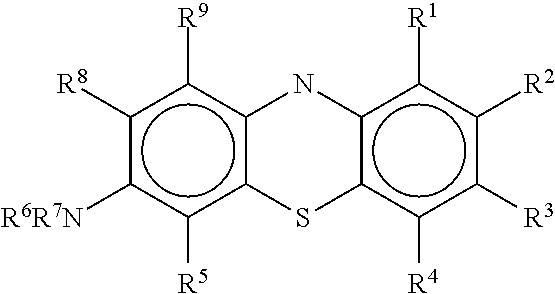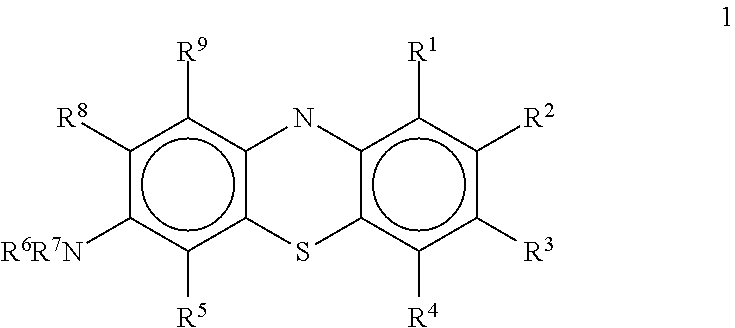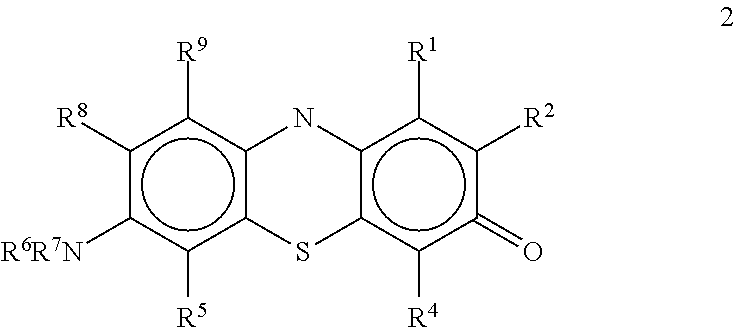Antiviral compounds
a technology of antiviral compounds and compounds, which is applied in the field of compounds for preventing and treating viral infections, can solve the problems of affecting the effect of antiviral treatment, affecting the safety of patients, and causing toxic effects,
- Summary
- Abstract
- Description
- Claims
- Application Information
AI Technical Summary
Benefits of technology
Problems solved by technology
Method used
Image
Examples
example i
General Example I
Synthesis of 7-Amino-Substituted 3H-Phenothiazin-3-One Compounds
7-(Pyrrolidin-1-yl)-3H-phenothiazin-3-one
[0112]
1. Synthesis of Phenothiazin-5-ium Tetraiodide Hydrate
[0113]Phenothiazine (9, 566 mg, 2.84 mmol) was dissolved in CHCl3 (20 mL) and cooled to 5° C. To this solution was added a solution of I2 (2.16 g, 8.51 mmol) dissolved in CHCl3 (50 mL) was added over the course of 1 h. The reaction was stirred for 1 h more at 5° C. and a dark solid precipitated. The solid was stirred in ethyl ether for 1 h and filtered. The solid was dried under vacuum to give a quantitative yield of 2.00 g.
2. Synthesis of 3-Aminophenothiazin-5-ium Triiodide (10)
[0114]The phenothiazin-5-ium 1.65 g, 2.34 mmol) was dissolved in CHCl3, and pyrrolidine (0.39 mL, 4.67 mmol) was added dropwise. The mixture was stirred at RT for 48 h. The solvent was decanted and washed three times with ethyl ether. The crude material was used without purification.
3. Synthesis of 7-(Pyrrolidin-1-yl-3H-phenothia...
example ii
General Example II
Synthesis of 1,9-Dimethylphenothiazin-5-ium
[0116]
1. Synthesis of Di-ortho-tolylamine (13)
[0117]A round-bottom flask was heated, and then allow to cool to room temperature under argon. To the flask were added Pd2(dba)3 (1.39 g, 1.52 mmol, 1.0 mol %) or Pd(dba)2 (1.38 g, 2.4 mmol, 1.4 mol %), 2-(di-tert-butylphosphino)biphenyl (1.09 g, 3.65 mmol, 2.4 mol %), 2-bromotoluene (12, 40 mL, 332.1 mmol) or 2-chlorotoluene (39 mL, 332.1 mmol), lithium amide (3.47 g, 151.1 mmol, 45 mol %), sodium t-butoxide 29.5 g, 297.7 mmol, 90 mol %), then toluene (150 mL). The reaction mixture was heated at 80° C. under argon overnight, then allowed to cool to room temperature. The resulting liquid was diluted with diethyl ether, and then filtered through a pad of celite. The resulting cocnentrte was filtered in vacuo and used in the next reaction without purification. The crude material was purified by column chromatography with hexane to give the product as white crystals with a yellow ...
example iii
General Example III
Synthesis of 1,9-Diethyphenthiazin-5-ium
[0120]
1. N-(2-Ethylphenyl)acetamide
[0121]To the stirred solution of commercially available ethyl aniline (16, 20.3 g, 167.5 mmol, 1 eq.) in anhydrous pyridine (90 mL), at zero degree, under argon was added acetic anhydride (32 mL, 335.04 mmol, 2 eq). After the addition, the resulting solution was stirred with warming to room temperature overnight. The reaction solution was cooled (0° C.), pH adjusted between 4 and 5 with 10% HCl, and extracted with ethyl acetate (2×500 mL). The combined organics were washed with brine, dried (Na2SO4), filtered and concentrated to provide the title compound as a white solid.
2. N,N-bis(2-Ethylphenyl)acetamide
[0122]The mixture of the N-(2-ethylphenyl)acetamide (7.35 g, 45.03 mmol), anhydrous K2CO3 (6.22 g, 45.03 mmol), copper(I) bromide (452.2 mg, 3.15 mmol) in 1-bromo-2-ethylbenzene was stirred and heated to 200° C. under argon for 48 h. After cooling the reaction mixture was poured into ice-H...
PUM
| Property | Measurement | Unit |
|---|---|---|
| temperature | aaaaa | aaaaa |
| temperature | aaaaa | aaaaa |
| temperature | aaaaa | aaaaa |
Abstract
Description
Claims
Application Information
 Login to View More
Login to View More - R&D
- Intellectual Property
- Life Sciences
- Materials
- Tech Scout
- Unparalleled Data Quality
- Higher Quality Content
- 60% Fewer Hallucinations
Browse by: Latest US Patents, China's latest patents, Technical Efficacy Thesaurus, Application Domain, Technology Topic, Popular Technical Reports.
© 2025 PatSnap. All rights reserved.Legal|Privacy policy|Modern Slavery Act Transparency Statement|Sitemap|About US| Contact US: help@patsnap.com



